As some users might assume, Vertex Mapping is not directly related to texture mapping, but can play an important role when texturing models for rendering. Put simply, Vertex Mapping is a means of storing vertex specific information within a model for variety of uses. Sometimes they act as instructions to tell a certain function how to act upon a model, as with Weight Maps. Sometimes they store positions offset information as in Morph maps. They can also store 2D coordinate information defining how textures apply to a surface by way of a UV map. Regardless of the map type, vertex maps have proven utility and are essential to working in 3D. As with modeling, there are a variety of options for creating, displaying and working with Vertex maps in modo.
Vertex Map Types
Weight Maps--
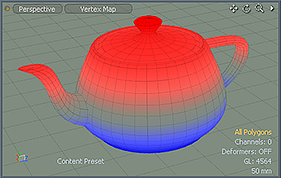
Used for a variety of purposes, a weight map can be used to modulate the strength of a tools effect when combined with a weight falloff operator, or used to control the smoothing properties of a Subdivision Surfaces model by adjusting the subdivision weight map, in effect controlling how round or sharp a corner crease becomes when converted to Subdivision Surfaces. The Shader Tree can utilize Weight Maps for modulating surface attributes, with Masks and Gradients. They can also be exported to LightWave, Maya or other applications that support them for use in texture or deformation modulation. Weight maps are discontinuous one-dimensional vertex maps holding weight percentages. When a 3D viewport is set to the type 'Vertex Map' shading mode, a weight value of zero is represented with a neutral green shade while a negative weight value is visualized with a blue, “cool†shade and a positive value is displayed as a red, “warm†shade.
UV Maps--
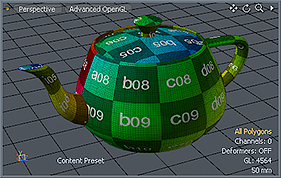
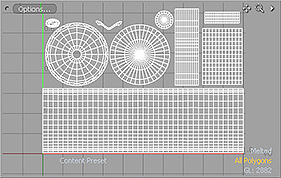
UV maps are used to explicitly link vertices in the 3D mesh to locations on a 2D image for high accuracy texture mapping. UV Maps are stored as discontinuous 2D vertex maps values for 0-1 UV coordinate data. The UV map can be though of as a method to unfold any 3D mesh so that it lays flat, allowing the 2D image to be applied to the mesh more accurately.
Morph Map--
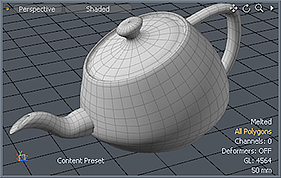
Morph maps offer users a means of saving alternate deformations for any model. Individual morph map deformations can be animated over time providing the ability to animate say for instance facial expression. In order to animate any morph map, a morph deformer must first be applied to the model. modo supports two varieties of morph maps, relative and absolute. Relative will offset a particular vertex relative to its current position, and absolute will position a vertex to a specific absolute position. Relative vertex maps are the more common variety. The main benefit to working with morph maps in modo is any topology changes made to a specific morph maps will be applied to all the associated maps.
Color Maps--
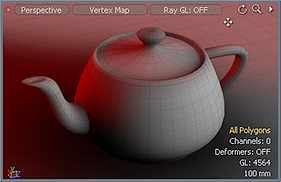
modo provides support for RGB and RGBA vertex color maps. Vertex color maps are often used in games to provide additional color variations in combination with texture maps simulating a fully shaded environment with little to no CPU shading overhead. Vertex color maps can be 'painted' by using the 'Vertex Map > Color Tool' combined with an 'Airbrush' type falloff.
Vertex Normal--
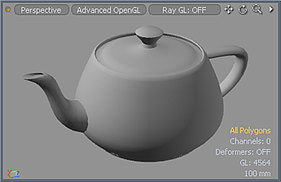
Vertex Normals work in tandem with the Smoothing function to shade polygons as either faceted or smooth. A Vertex Normal map is effectively the values of the Smoothing setting baked into the vertices. Most often, Vertex Normal maps are generated in an external CAD package when converting a Nurbs based model to polygons. The normal values are computed from the smooth nurbs surface eliminating smoothing errors of the highly triangulated polygonal surface when rendered elsewhere.
Particle Maps--
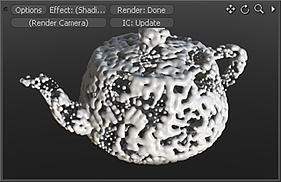
Particle Maps are useful in giving users control over particle and volume related items such as when using point clouds for Replicators and Texture Replicators and for use with Blobs, Volumes and Sprites ('point clouds' are just masses of particles). This includes 'Dissolve Maps' which control the opacity of individual particles and 'Size Maps' which control the scale of individual particles.
Transform Maps--
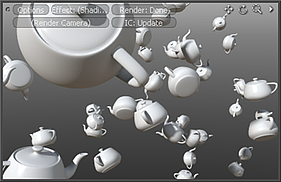
Vertex Transform Maps are useful as they give users individual control over Replicators, as users can apply a Transform Map, then then selecting a target vertex (with a Replicated element applied) and using the standard transform tools, users can adjust rotations, scale and positions on an individual particle basis.
Other Maps--
modo also offers support for various other maps types, such as Pick Maps. This is mainly for the storing of selection sets and compatibility with other applications.
INFO: Particle Maps cannot be applied to procedural particle items, such as 'Particle Clouds' and the 'Particle Generator'.
Lists viewport
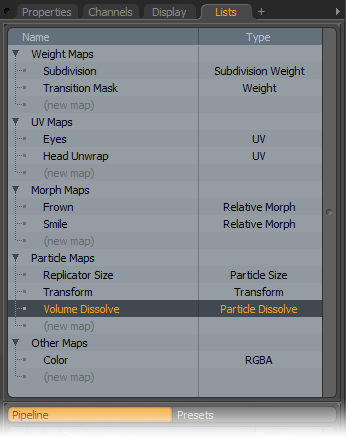
While map specific information is stored within the model itself at the vertex level, Vertex maps, like Item layers, are organized within the Lists viewport panel. Within the viewport, users can select and deselect maps making them active for editing. Maps can also be created, deleted and renamed from within the Lists view. The various options are available by RMB+clicking on a vertex map name and choosing from one of the option in the pop-up context menu. The List view doesn't see as much action as the Item List or Shader Tree viewports, but the functions it provides are essential to working with vertex maps. All the attributes of the viewport are covered in the Vertex Map List viewport page of the documentation.
TIP: Vertex Maps are item layer specific, with each mesh item having its own dedicated maps. The only maps visible within the Lists viewport are for layers that are likewise visible (Controlled by the Item List). While different layers can share map names (and usually do if users stick with the default names modo generates), this can cause collision problems, producing incorrect results when baking out texture maps for rendering or export.
Managing Vertex Maps
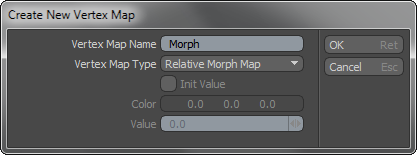
Before adding a map to a mesh, users need to first determine the type of map required--
| Map Type | Description | |
| Weight Map | Weight Strength Values stored for Falloff and Texturing purposes | |
| SubD Weight Map | Weight Strength Value influences edge creasing in SubDivision Surface geometry | |
| UV Map | UV maps translates 3D vertex positions to flat 2D coordinates | |
| Relative Morph Map | Vertex position offset, relative to the base vertex position | |
| Absolute Morph Map | Vertex position offset to specific absolute position in 3D space | |
| RGB Map | Vertex Color map defined by three R, G and B color values | |
| RGBA Map | Vertex Color map defined by three R, G and B color and an additional Alpha value | |
| Pick Map | Like a Selection Set, defines groupings of vertices | |
| Vertex Normal Map | Surface Normal direction (Smoothing) values stored as fixed value | |
| Edge Pick Map | Like a Selection Set, defines groupings of edges | |
| Particle Size Map | Determines scale values for individual particles | |
| Particle Dissolve Map | Determines transparency values for indvidual particles | |
| Transform Map | Determines transform amounts for individual vertices/particles |
Creating a new map can be accomplished from the menu bar "Vertex Map > Create...". This opens the 'Create New Vertex Map' dialog where users can select the map type, define a name for the map, and set a base value. LMB+clicking OK creates the map for the currently selected mesh item layer(s), with the named map immediately available within the appropriate section of the Lists viewport. Users may also select any of the '(new map)' options available directly in the Lists viewport under each map type, in turn opening the 'Create New Vertex Map' dialog with a pre selected map type defined by which section the map was created under.
Renaming of maps can be accomplished by either RMB+clicking on a map name and choosing 'Rename' from the popup context menu, or by selecting a map within the list, so it is highlighted, and choosing the menu bar command "Vertex Map > Name...". This opens a dialog box where users can enter the new name, making sure to choose the proper map type (unnecessary when using the rename option in the list). Additionally, users may also use the LMB+click pause click method to rename the layer inline. Removing maps can be done by selecting the target map and choosing the manu bar command "Vertex Maps > Delete". User may also simply select the layer and press the 'Delete' key.
Viewing and Editing Vertex Maps
How users go about displaying and editing Vertex Maps depends on the map type. For most types of maps, this is done directly in the 3D viewports, providing real time feedback to changes in value.
Weight Maps--
Weight Maps display directly in any 3D viewport, when the viewport display option are set as type 'Vertex Map'. Maps can be edited by selecting components and applying values, or using the 'Weight Tool' function. Combined with a 'Airbrush' falloff, interactive painting' of weight values can be accomplished.
UV Maps--
UV maps have their own 2D viewport, specific to editing maps of these types. 3D viewports only display the result of the UV map in the 'Texture', Texture Shaded' or 'Advanced OpenGL' modes. For user convenience modo has a dedicated UV editing layout, by default, with additional popup windows available under the "Layout > Windows" option in the menu bar.
Morph Maps--
When a Morph maps is enabled/selected in the Lists viewport, they are visible within any of the 3D viewports in all of the various modes. When animating morph maps, applied as a deformer, the morph itself will only be visible if the 'Enable Deformers' option is set as such within the viewport options (Access able by pressing the 'O' when hovering the mouse pointer over the target viewport). This is the default option for the 'Layout', 'Animation' and 'Render' layouts, but is disabled in the Modeling, Painting and UV view Layouts.
Color Maps--
When a Vertex Color Map is enabled/selected in the Lists viewport, it will display directly in any 3D viewport, when the viewport display option are set as type 'Vertex Map'. Maps can be edited by selecting components and applying values, or using the 'Color Tool' function. Combined with a 'Airbrush' falloff, interactive painting' of vertex color values can be accomplished.
Vertex Normals--
Vertex Normals, when present, override any smoothing settings, as defined by Material item settings in the Shader Tree. Vertex Normals are usually generated in an external application and used when rendering highly triangulated CAd in modo. However, modo offers the option to bake the Material Items smoothing results into a vertex Normal maps with the 'Set Vertex Normals' Command.


